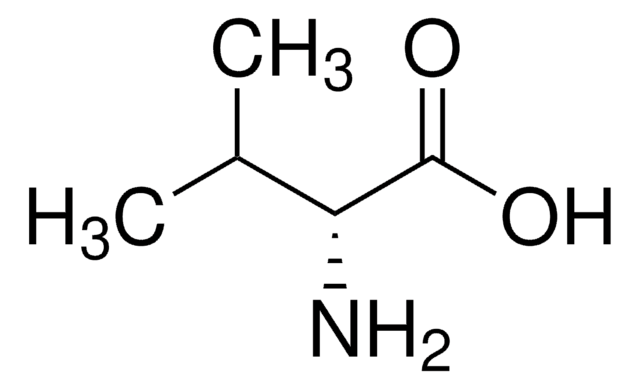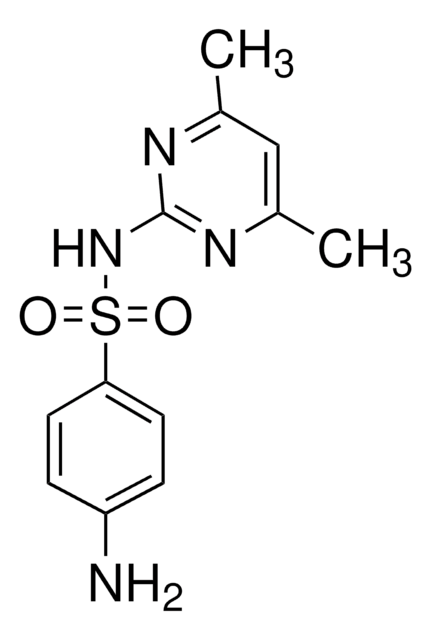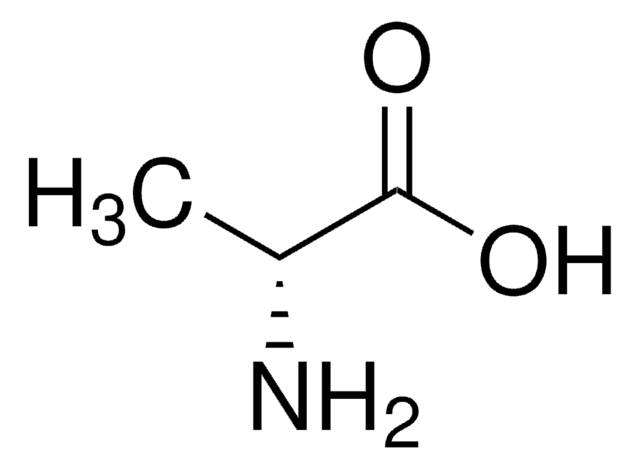V1255
D-Valine
BioReagent, suitable for cell culture
Synonym(s):
(R)-α-Aminoisovaleric acid, D-2-Amino-3-methylbutanoic acid
Sign Into View Organizational & Contract Pricing
All Photos(4)
About This Item
Linear Formula:
(CH3)2CHCH(NH2)CO2H
CAS Number:
Molecular Weight:
117.15
Beilstein:
1721135
EC Number:
MDL number:
UNSPSC Code:
12352209
PubChem Substance ID:
NACRES:
NA.75
Recommended Products
biological source
synthetic (organic)
Quality Level
product line
BioReagent
form
powder
technique(s)
cell culture | mammalian: suitable
mp
>295 °C (subl.) (lit.)
shipped in
ambient
storage temp.
room temp
SMILES string
CC(C)[C@@H](N)C(O)=O
InChI
1S/C5H11NO2/c1-3(2)4(6)5(7)8/h3-4H,6H2,1-2H3,(H,7,8)/t4-/m1/s1
InChI key
KZSNJWFQEVHDMF-SCSAIBSYSA-N
Looking for similar products? Visit Product Comparison Guide
General description
L-Valine is an essential non-polar amino acid. D-Valine is the non-proteinogenic isomer of valine.
Application
D-Valine has been used as a supplement in:
- Dulbecco′s modified Eagle′s medium (DMEM)/Nutrient Mixture F-12 Ham (F-12) for mice renal proximal tubule cell (RPTC) culture
- endothelial cell growth medium MV2 for rat lung microvascular endothelial cell (RLMEC) culture
- DMEM/F-12 for mouse tracheal epithelial cell (MTEC) culture
Biochem/physiol Actions
D-Valine has a broad range of industrial applications such as semi-synthetic veterinary antibiotics, pharmaceutical drugs, and agricultural pesticides.
D-valine is used in cell culture as a selective inhibitor of cell proliferation, wherein it inhibits cells that lack the enzyme D-amino acid oxidase. Historically D-valine has been used to inhibit fibroblast growth while allowing selective growth of epithelial cells.
Storage Class Code
11 - Combustible Solids
WGK
WGK 3
Flash Point(F)
Not applicable
Flash Point(C)
Not applicable
Personal Protective Equipment
dust mask type N95 (US), Eyeshields, Gloves
Choose from one of the most recent versions:
Already Own This Product?
Find documentation for the products that you have recently purchased in the Document Library.
Customers Also Viewed
Elham Mohammadi et al.
Cell and tissue research, 362(3), 597-609 (2015-06-13)
Efficacy of therapeutic angiogenesis needs a comprehensive understanding of endothelial cell (EC) function and biological factors and cells that interplay with ECs. Stem cells are considered the key components of pro- and anti-angiogenic milieu in a wide variety of physiopathological
V A Lazzaro et al.
Research communications in chemical pathology and pharmacology, 75(1), 39-48 (1992-01-01)
A selective cell culture medium, D-valine minimal essential medium (92 mg/l), has been developed to inhibit the proliferation of fibroblasts in cell culture (Gilbert & Migeon 1975). Substitution of D-valine for L-valine prevents fibroblast growth due to the absence of
Ming Chen et al.
World journal of microbiology & biotechnology, 32(10), 171-171 (2016-08-28)
D-Valine is an important organic chiral source and has extensive industrial application, which is used as intermediate for the synthesis of agricultural pesticides, semi-synthetic veterinary antibiotics and pharmaceutical drugs. Its derivatives have shown great activity in clinical use, such as
Hui Li et al.
PLoS pathogens, 14(1), e1006821-e1006821 (2018-01-05)
The highly pathogenic avian influenza (HPAI) H5N1 influenza virus has been a public health concern for more than a decade because of its frequent zoonoses and the high case fatality rate associated with human infections. Severe disease following H5N1 influenza
Phillip C Calder
The Journal of nutrition, 136(1 Suppl), 288S-293S (2005-12-21)
Although there has been great interest in the effects of amino acids on immune function, little is known about the impact of changes in BCAA availability on the ability of the immune system to function. Human immune cells incorporate BCAA
Our team of scientists has experience in all areas of research including Life Science, Material Science, Chemical Synthesis, Chromatography, Analytical and many others.
Contact Technical Service










